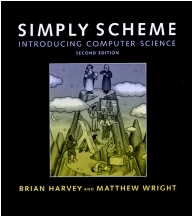
| Brian
Harvey University of California, Berkeley |
| Matthew
Wright University of California, Santa Barbara |
| Download PDF version |
| Back to Table of Contents |
| BACK chapter thread NEXT |
| MIT Press web page for Simply Scheme |

|
|
The three big ideas in this part are effect, sequence, and state.
Until now, we've been doing functional programming, where the focus is on
functions and their return values. Invoking a function is like asking a
question: "What's two plus two?" In this part of the book we're going to
talk about giving commands to the computer as well as asking it questions.
That is, we'll invoke procedures that tell Scheme to do something,
such as wash-the-dishes. (Unfortunately, the Scheme standard
leaves out this primitive.) Instead of merely computing a value, such a
procedure has an effect, an action that changes something.
Once we're thinking about actions, it's very natural to consider a sequence of actions. First cooking dinner, then eating, and then washing the dishes is one sequence. First eating, then washing the dishes, and then cooking is a much less sensible sequence.
Although these ideas of sequence and effect are coming near the end of our book, they're the ideas with which almost every introduction to programming begins. Most books compare a program to a recipe or a sequence of instructions, along the lines of
to go-to-work get-dressed eat-breakfast catch-the-bus
This sequential programming style is simple and natural, and it does
a good job of modeling computations in which the problem concerns
a sequence of events. If you're writing an airline reservation system, a
sequential program with reserve-seat and issue-ticket commands
makes sense. But if you want to know the acronym of a phrase, that's
not inherently sequential, and a question-asking approach is best.
Some actions that Scheme can take affect the "outside" world, such as
printing something on the computer screen. But Scheme can also carry out
internal actions, invisible outside the computer, but changing the
environment in which Scheme itself carries out computations. Defining a new
variable with define is an example; before the definition, Scheme
wouldn't understand what that name means, but once the definition has been
made, the name can be used in evaluating later expressions. Scheme's
knowledge about the leftover effects of past computations is called its state. The third big idea in this part of the book is that we can write
programs that maintain state information and use it to determine their
results.
Like sequence, the notion of state contradicts functional programming. Earlier in the book, we emphasized that every time a function is invoked with the same arguments, it must return the same value. But a procedure whose returned value depends on state—on the past history of the computation—might return a different value on each invocation, even with identical arguments.
We'll explore several situations in which effects, sequence, and state are useful:
| • | Interactive, question-and-answer programs that involve keyboard input while the computation is in progress; |
|---|
| • | Programs that must read and write long-term data file storage; |
|---|
| • | Computations that model an actual sequence of events in time and use the state of the program to model information about the state of the simulated events. |
|---|
After introducing Scheme's mechanisms for sequential programming, we'll use those mechanisms to implement versions of two commonly used types of business computer applications, a spreadsheet and a database program.
Brian Harvey,
bh@cs.berkeley.edu